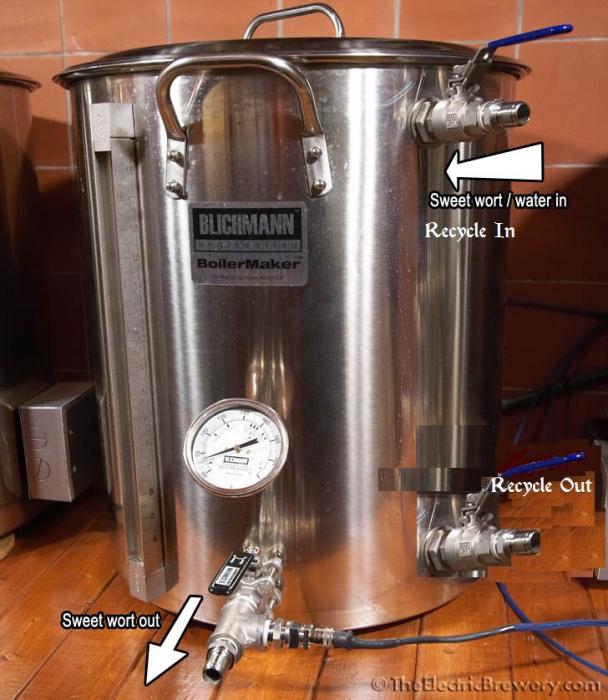user 78027
Well-Known Member
- Joined
- Apr 15, 2011
- Messages
- 274
- Reaction score
- 13
I currently am a BIAB brewer with a few, 15ish, batches completed. I do small 2.5 gallon batches and I like to do them often. I tend toward the concepts that give me more control and precision.
I was trying to sort out the differences between the BIAB Mash/Lauter process and the traditional Mash Lauter Tun and came to the conclusion that BIAB is simply using the same kettle for the Mash and the boil. I know, slow learner .
.
I was looking at a bunch of threads, the bad kitty brewery
https://www.homebrewtalk.com/f170/bad-kitty-brewery-ebiab-431276/
110v Recirculating eBIAB 2.5 gallon batches
https://www.homebrewtalk.com/f170/110v-recirculating-ebiab-2-5-gallon-batches-341219/
and many more.
I also looked at the awesome electric brewery site
http://www.theelectricbrewery.com/
I was all set to build a small 110V electric brewery with the info available on electric brewery, but would like to keep the equipment somewhat simpler if I could. So I thought, why not build a kettle that is a combination of the boil kettle and the MLT.
I really am fond of the Herms coil as a way of keeping the mash closer to a constant temperature. Thats the real problem with my arrangement now, along with the fact that the propane causes me a pain to keep filled.
I put all of this together and thought why not build a kettle like the MLT in the electric brewery site and add 2 things.
1) a heating element at the bottom to heat the wort in the mash and the boil.
2) a valve port below the sweet wort port to combine with the sweet wort port for recycling. The recycling pump then connects these two ports together to aid in keeping the temperature closer to the target. It can even be built in like in the recycling eBIAB arrangement. Use the same tubing on the inside as the electric brewery MLT for the return/recycled wort and there is very little difference between this arrangement and the traditional 3 kettle one.
The bag would have to be different, it would have to have a notch in the top to go under the sweet wort port and the MLT and something will need to be done with the silicone tube during the boil.
With permission from kal at the electric brewery I have made a sloppy modification to his MLT kettle image as an example.

I was trying to sort out the differences between the BIAB Mash/Lauter process and the traditional Mash Lauter Tun and came to the conclusion that BIAB is simply using the same kettle for the Mash and the boil. I know, slow learner
 .
.I was looking at a bunch of threads, the bad kitty brewery
https://www.homebrewtalk.com/f170/bad-kitty-brewery-ebiab-431276/
110v Recirculating eBIAB 2.5 gallon batches
https://www.homebrewtalk.com/f170/110v-recirculating-ebiab-2-5-gallon-batches-341219/
and many more.
I also looked at the awesome electric brewery site
http://www.theelectricbrewery.com/
I was all set to build a small 110V electric brewery with the info available on electric brewery, but would like to keep the equipment somewhat simpler if I could. So I thought, why not build a kettle that is a combination of the boil kettle and the MLT.
I really am fond of the Herms coil as a way of keeping the mash closer to a constant temperature. Thats the real problem with my arrangement now, along with the fact that the propane causes me a pain to keep filled.
I put all of this together and thought why not build a kettle like the MLT in the electric brewery site and add 2 things.
1) a heating element at the bottom to heat the wort in the mash and the boil.
2) a valve port below the sweet wort port to combine with the sweet wort port for recycling. The recycling pump then connects these two ports together to aid in keeping the temperature closer to the target. It can even be built in like in the recycling eBIAB arrangement. Use the same tubing on the inside as the electric brewery MLT for the return/recycled wort and there is very little difference between this arrangement and the traditional 3 kettle one.
The bag would have to be different, it would have to have a notch in the top to go under the sweet wort port and the MLT and something will need to be done with the silicone tube during the boil.
With permission from kal at the electric brewery I have made a sloppy modification to his MLT kettle image as an example.



























































![Craft A Brew - Safale S-04 Dry Yeast - Fermentis - English Ale Dry Yeast - For English and American Ales and Hard Apple Ciders - Ingredients for Home Brewing - Beer Making Supplies - [1 Pack]](https://m.media-amazon.com/images/I/41fVGNh6JfL._SL500_.jpg)
